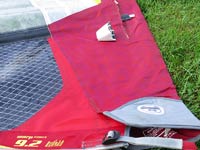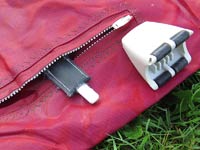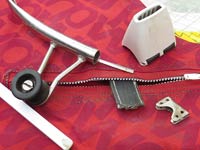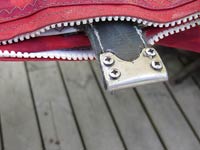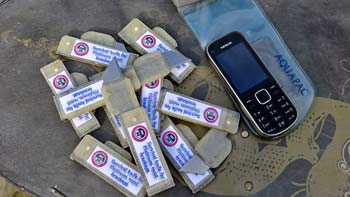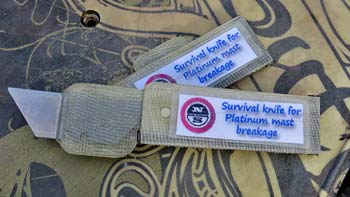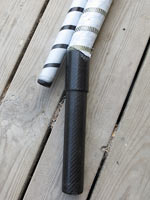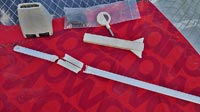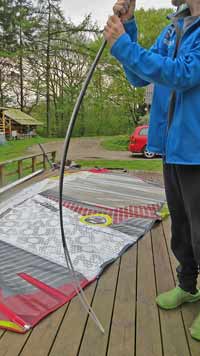October 2014.
On North Warp, a personal review.
6 years with the Warps.
Important:
This is an advancing review, written gradually as new experiences have
emerged. Consequently, you may find conflicting information. If so, the
latest updates overrule earlier writings.
Some 6 years ago I finally gave up sailing with Neil Pryde race sails. Having sailed the brand for many years I was indeed very happy with the general performance of the sails. Strong in all disciplines and very intuitive and friendly to sail.
But
they certainly had their issues. First of all they were much too
frail - cracking their luff panels, breaking
their top and bottom straps, maculating their extremely complex (but
hard rotating) camber inducers,
breaking their batten tips when de-rigged etc. Oh, and breaking their masts,
probably because of too extreme a luff curve. And on top of that
a culture within the company that always blamed the costumers
for
incorrect
handling of the Neil Pryde equipment when it broke. Evidence of this
sad story can be seen here:
http://peterman.dk/windsurf-NP-RS-series-780gb.htm.
So, no Neil Pryde anymore - but then what? After the Neil Pryde experience the first and foremost criterias were reliability, no-nonsense construction, and back-up from the company. And if these qualities came at a price (in terms of money or reduced performance), then so be it. I was looking for contrasts to my Neil Pryde era.
The arrow quickly
pointed at Northsails. North has a reputation of making quality products
that are tested out and that are backed up
by
fine guarantees. As to the sails North seems
to be rather conservative
with not too many "breakthroughs" (good!). And
where their
corporate
culture
is concerned
they seem
to
have a more
European (German-Austrian)
attitude
than
an
American/Far
Eastern attitude, which
we've come to associate with
un-reliability, empty words and strict
cost-benefit focus. Well at least
that were
the expectations of me and my son,
who joined
me in my
switch
to
North Sails.
Experiences with the Warp sails.
Just to clarify: We're certainly no slalom racers. What we do, I guess, can best be described as "freeracing". That is sailing with our surf buddies, covering relative large areas (long legs of upwind, downwind and beam reaches) in a variety of sea conditions and wind strengths - and where the main objective is simply to not be the slowest guy on the water. Jibes are mostly necessary evils that often turn into pure punishment.
If you're curious
about
our
(moderate)
level and way of
sailing, here are a couple of videos
to give you an idea:
https://vimeo.com/album/2851238/video/73816539,
https://vimeo.com/album/2851238/video/71924037, (and more here:
https://vimeo.com/album/2851238).
Our
evaluation of the
Warps are of course subjective and in no way the result of structured,
comparative testing.
Durability.
None of our (almost
20) Warp sails have had any of the fatal faults with cracked luffs that
haunt the Neil Pryde race sails (and to a lesser degree a couple
of other brands we've had
short experiences with,
for instance Severne Reflex
II). The closest we've come to that fault was a
North Ram from 2008 that cracked in the luff panel a year and a half
from the date of
purchase. And
for
that sail,
repair was not "offered" within
a couple of months (as is
common
practice in my country for Neil Pryde sails -
if
the sail is less than 6 months old!). No, the sail was
immediately replaced with a new Ram model 2010. But
like I said: No
such issues with the Warps.
The only complaint
we've had
about
the durability of the sails turned up this spring,
when the bottom camber on my Warp 9.2 F2013 refused to rotate.
Upon
examination it
turned out
that the batten had penetrated the batten pocket
and jammed against
the mast through the camber inducer.
The
warranty "offer"
from the North
company was not that
impressive (50 Euros to have it repaired at a
sail loft), so I
respectfully declined and
found a way to repair it myself. What happened to
the 5 years warranty ... !?
The bottom camber in the F2013
9.2 refused to rotate. With the
camber removed it's obvious why.
Click the picture to enlarge.
Only in no-cam sails have I witnessed
the batten running out through the
batten pocket after rubbing against
the mast. Here there was no rubbing.
Click the picture to enlarge.
A kind of solution: Fixing a batten
pocket end from an old "Reactor
Bar."
Click the picture to enlarge.
The new batten pocket end is exactly
narrow enough to squeeze inside the
camber. With guarantee that the problem
won't ever be coming back.
Click the picture to enlarge.
I'm still
a bit puzzled about the damaged
batten pocket, as the tip of the pocket never touched he mast.
The hole
in the batten pocket tip consequently wasn't the result of wear by
rubbing against the mast.
I suspect
that generally the F2013 Warps are built a little more flimsily than
normal North standard, and that this is reflected by the mere 2 years warranty for
F2013s in contrast to the normal 5 years warranty for all other Warps.
Never mind,
on the
whole
this has been our only complaint
about the durability/craftsmanship of the Warps.
Bottom cambers are pretty
tough to polyamide coating of the masts, so the masts have to be strengthened from time to
time with a little resin filled glass- or carbon weave. I recon that
this little issue isn't a problem for North alone.
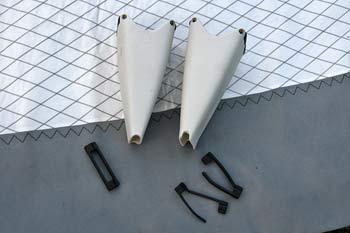
After long time of use (years) the relatively soft plastics
of the cams show sign of wear (the camber to the right).
If you use a spacer shim in an already deformed
camber, it'll break.
Compare to the new camber and shim to the left.
Click the picture to enlarge.
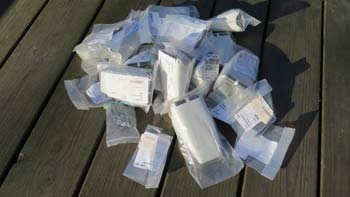
It takes a long time before the cambers wear out and
need to be replaced. But then, why the necessity for
all my spare cambers, you'll perhaps wonder.
The reason is simply that every time a Platinum mast
breaks inside a Warp, it splits open the mast pocket
- and at least one (most often two) cambers disappear
into the sea.
Click the picture to enlarge.
Performance.
As stated: We didn't
convert to North Warp
for reasons of
performance. And to be honest, generally the North Warps
have their own distinct "taste" compared to the majority of race sails
from other brands. Let's break up the picture a little:
The pros.
1. Superior camber
rotation.
The Warps have
always (well, at least the last 6 years) been trendsetter in effortless
rotation. Compared to other race sails the cams (the "hypercams" that
is) have a no-nonsense design, they are made from relatively soft
plastics,
and the rollers are placed in front of the cambers. To
my
knowledge, there are no
downsides
to
this design - for instance the profile
stability is at least as good as the competitors'.
2. Very good top
speed.
The speed in high
(and partly in medium) winds is very good, at least if you have the
power/weight to handle the sail. So, at least
on flat water you can make
some very fast runs.
3. Great profile
stability.
Also, the stability
of the profile is extremely good. In fact we've very seldom (if ever)
experienced a problem with an
overpowered Warp per se. When we've felt overpowered the problems have
almost always been with
the rider
(not having the power/weight to tame the sail) or the design/trim of the
fin or board, resulting
in tail walking or not managing the chop convincingly.
4. Explosive acceleration in high winds.
This is the positive side of the very direct feel you have with the Warps. No doubt that if you have plenty of wind and keep sheeting in the Warp during the first meters of planing, it'll reward you with serious speed very quickly. Don't expect the Warp to dampen the power.
5. Very light weight
(static).
The static light
weight of the Warps have been paramount to the competitors the last
several years - partly because of the 7 battens
design. And the
dynamic feel of the Warp is also pretty good. The lack of "grunt" helps
in this respect, while the directness and nervousness retracts a little.
The cons.
1. Poor low end
power.
Poor planing
ability, poor pumpability, lack of low end power and only moderate speed
in light winds are Warp (and generally other sails from North)
characteristics. Sail designs are
the result
of certain choices, and
apparently some choices
are mutually exclusive. It's pretty obvious
that some Warp-qualities (very stiff and rigid with
comparable
shallow profile) don't leave room for the Warps to excel in low winds. And
North knows what the main
complaint has always been: Every year
for the last 6-7
years,
the presentations of the next year Warp have
claimed that NOW North
has addressed the very same low-end problem. Have a look:
2009:
"Better acceleration" obtained by "lower tension for the mast sleeve
area ..."
2010:
"Better acceleration and pull", obtained by "deeper profile ..."
2011:
"Better acceleration", obtained by "tweaked profile ..."
2012:
"Maximum acceleration", obtained by "fuller profile ..."
2013:
"Improved low-end acceleration and pumpability", obtained by "deeper
profile and higher flexibility ..."
2014:
"Low-end power and acceleration", obtained by "increased profile in the
upper luff area ..."
2015:
"More low-end power and pumping ability", obtained by "reduced luff
curve ..."
The funny thing is,
that in spite of all these
claimed efforts the Warps have never excelled in the low end
disciplines
in (for instance) the Planchemag
magazine slalom sail
tests over the years (see
links below).
If North really thinks the
Warps
have been improved
in this respect -
then the
competitors have improved more. Maybe the F2015
will
prove to be an exception,
but the need of a special LW 9.0 in the line up may be indicative of
otherwise ...
*) This is the last few lines from a "micro-test express" of the all new Warp F2015 7.7 in Planchemag. No. 367, Oct/Nov. 2014:
"The F2015 7.7 is very balanced, with a little more power to the back hand than last year. The passage of the cams is probably the best in the market. A stiff sail, that are more nervous than most others."
Seems that the Warp F2015 stick to the same distinct Warp character that we've come to know from the previous years. But perhaps a little more low end power?
We feel that
the
Warp
with the best low end performance
has been the F2012, followed by the F2013.
Unfortunately the (generally very good) F2012 is probably also the
stiffest sail of the lot, having a massive (and mast-breaking!) luff
curve.
2. Questionable control, unless you're a heavyweight.
If you think that
the very fine profile stability of the Warps results in good control,
you'll probably be disappointed. That is, at least if you're not a
heavyweight. For
riders under approx. 85 kg the
stiffness/directness/nervousness of the Warps (sailed with the Platinum
masts) are so overwhelming that you'll have a hard time controlling it
in high winds, especially in chop. It simply feels that the Warps dump
the power too late for the
sub-85
kg
riders.
For several years some sizes of the Warps were recommended with 30 cm longer masts than the competitors. So, until the F2013 Warps you had the opportunity to rig some of your Warps with shorter (= softer and slightly more relatively Flex Top, se this study: http://peterman.dk/windsurf-NP-X6-mast-study-780gb.htm) masts than were recommended. For instance, you could rig your Warp 7.0 with a 430 cm mast instead of the recommended 460 cm mast - or you could rig your Warp 7.8 with a 460 cm mast instead of the recommended 490 cm mast - or you could rig your Warp 9.3 with a 490 cm mast instead of the recommended 520 cm mast. My son (approx. 60 kg) and I (approx. 80 kg) have mostly rigged our Warps on the smallest masts possible, just to have a chance to survive in really high winds and chop. But as the latest Warps (F2014 and on ...) are now generally recommended with as short masts as the competitors, that possibility no longer exists (except for the 7.0).
In our view the most
controllable Warp has been the F2013, closely followed by the F2012.
In the other end
we find
the F2011, that we've
judged to have a
pretty narrow area of use.
Why this distinct performance character of the Warps?
I'm a little curious
why North hasn't addressed the combination of questionable
controllability (for lighter sailors) and poor low end power. Is it
because the boards North test their sails with are very controllable and
early planing boards (for instance the Starboard iSonic series), so that
the performance character of the Warps
is
not noticeable for the
developers and
testing crew? No, in fact the North Warps seem to be
tested with the Fanatic Falcon series (also from the Boards & More
company),
which has a reputation of fine
top speed, but was never
known for early planing or controllability (possibly because of designer Wenzels love for tail kicks and
relatively short
flats).
So,
I'm still curious why the Warps year after year are biased towards this
unforgiving stiffness/directness/nervousness and
poor low-end power. As
indicated it seems that the sail performance characteristics of
North Warp are in line with the board performance characteristics of the
Fanatic Falcon. A Boards & More philosophy?
For the F2015
Warps,
North
says: "On water and comparison tests have shown that there can be "too
much" power and acceleration. If this is the case, the rider is
struggling so much with the rig that the optimum rake, an acceptable
handling and efficient transmission of the sail power into board speed
are no longer guaranteed. Loss of speed and control are the result.
Therefore designer
Kai Hopf has found the perfect balance between maximum acceleration and
optimum control when overpowered for each size of the new range,
matching the weight of the prototypical PWA slalom racer (between 90 and
100 kg)."
As I read the
statement,
North finally admits that the Warps generally have been a handful to
control near the upper wind limit - and that
acknowledgement
is definitely a
first step towards designing a more friendly race sail. However, the
last part of the statement completely ruins this prospect for the
not-so-heavy sailors.
Riders under 90 kg
will
apparently still feel the overwhelming stiffness/directness/nervousness
of the Warps. And you
no
longer have the option to rig the Warps with shorter
(=softer) masts than
recommended, as North now (as said) actually recommend relatively short
masts, in line with the competitors.
A wish.
Now that
it's no longer
possible to rig the Warps with shorter masts it might perhaps be a good
idea for North to learn from Loftsails. Here you
have the option to rig the race sails (Racing Blade) on RDM masts, if
you aren't a heavyweight and prefer a softer sail. Apparently the
Loftsails Racing Blade (above 6.3
square
meters) are delivered with cams that
fit
both
SDM and RDM masts. With the Warps being so stiff and
(declared to be) designed for the heavyweights, why not offer a RDM option
for lighter sailors?
Oh, a
A note on the trim
The F2009, F2010 and
F2011 we always had to rig with a very low placement of the boom. This
was the only way we could hold the nose of the board down and keep the
foot placed firmly in the front strap. Then suddenly, on the
relatively powerful
F2012 and F2013 we could raise the boom to "normal height" and still have a
fast and
controllable board feel
(we've
always ridden
boards from the RRD
X-Fire series).
However, that feel
totally disappeared again with our only Warp F2014 (a 7.8). Compared to
the Warp F2012 and F2013,
which were both fine performance-wise, our F2014 7.8 was a
disaster, and after
a few sessions on the water we gave it up.
Frankly, I
had to humiliate myself
by asking a windsurf buddy,
to
whom
I had given my old
F2012 7.8
(with several scars from
breaking masts),
to have it back - and compensate him with another Warp from
our surplus stock. We simply couldn't trim the F2014 - and I suspect
that
(apart from our lack of
ability)
it was the pretty odd design with more profile above the boom that
destroyed the trim. When measured and compared to
our F2012
7.8,
the F2014 7.8
has the profile placed a little more forward, and measured on the 3
lowest battens it had up to 1,5 cm less profile, while measured
on the two next battens it had up to 1,5 cm more profile depth.
Perhaps an even more Flex Top like mast than the 460 cm Platinum 2014
mast could have saved the trim of the sail?
Anyway, we gave up the sail that felt delicate and strangely "flimsy" to sail. It also felt a bit smaller than the previous Warp 7.8's, and as such it was difficult to fit into symmetric into the space between our Warp 8.6 (F2012) and the Warp 7.0 (also F2012). I don't know if North continues down this new road of design. Buying a new race sail is a lot about faith to the people around the designing process (you cannot have a test drive and when the magasines publish their tests its most often too late to order the sail).
NOTE/HENVISNING TIL SPECIEL SIDE: Probably unfair, but I'll have to say that the inclusion of Dani Aeberli in the North design team (and in the Fanatic team as well) might indicate fashion over sober designing. Have a look at this masterpiece from Dani Aeberli: . Hope not that this is the kind of ....that'll be built into the Warps in the years to come ...
We quickly gave up the Warp F2014 7.8 and althoug our quiver badly needs FORNYELSE we decided not to invest in any Warp F2015 sizes. Hopefully the UDVISTE performance of the
| Profiles along the battens. | ||||
| Warp 7.8 2012 | Warp 7.8 2014 | |||
| Draft | Depth | Draft | Depth | |
| position, cm | of draft, cm | position, cm | of draft, cm | |
| Batten 1 (lowest)) | 45 | 18,5 | 44 | 18,1 |
| Batten 2 | 57 | 23,4 | 53 | 22 |
| Batten 3 | 52 | 18,7 | 50 | 18,3 |
| Batten 4 | 42 | 9,1 | 35 | 10,5 |
| Batten 5 | 25 | 4,2 | 27 | 4,7 |
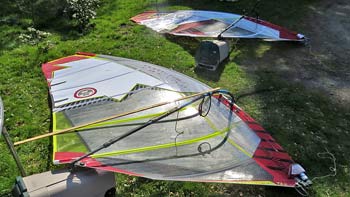
I simply couldn't figure out why I found the F2014 7.8 to
be such a lousy sail compared to the F2012 7.8 (and
the F2013 7.8 for that matter).
Here both sails are rigged with Platinum masts with
exactly the same stiffness and bend curves. It's not
easy to measure the profiles of the sails, but it
was given a try (see the numbers to the left).
Click the picture to enlarge.
Here are some links
to
what the French Planchemag magazine test crew thinks about the
performances of the
past
4 years of Warp sails:
F2011:
http://peterman.dk/windsurf-mag-dk-900-slalomsejl2011-70-71.htm.
F2012:
http://peterman.dk/windsurf-pro-mag-dk-900-racesejl-78m-01.html.
F2013:
http://peterman.dk/windsurf-mag-dk-1200-slalomsejl-76-79-01.htm.
F2014:
http://peterman.dk/windsurf-mag-dk-900-slalomsejl2014-77-79.htm.
Experiences with the Platinum masts.
Bend characteristics of the Platinum masts.
I remember from the
Cold War a theory about "convergence" between the two antagonistic types
of society.
In the Cold War
this convergence never really materialized, but in a totally
different ballgame
- the bend curves of windsurf masts - it's fair to talk about the mast
schools coming closer together. Proponents from the Hard Top school
(Barry Spanier/Phill McGain from (now) Maui Sails) have "adjusted" their
race masts to be Constant Curve, and so
too does
Gaastra
seem to have done in incremental steps. I'm a little more in doubt about
the race masts of Severne - but I suspect
that
the brand has followed the route of MS and Gaastra. Otherwise Severne
shall be pretty isolated.
In the opposite end of mast bend thinking, Neil Pryde stepped a little back from the extreme Flex Top idea a long time ago (since the Race Pro masts). But for several years NP has still been the leader of the stiff bottom section/soft top section philosophy (the smaller masts intended to be most Flex Top like). That's no longer the case: At least some brands have adapted (or perhaps even overtaken) the position of Neil Pryde these past years. And among these are North (Gun and probably others) with the Platinum series. Latest measurings of mast bend curves indicate that Norths race masts have catched up (overtaken?) the race masts from Neil Pryde in terms of having a relatively soft top section of the masts.
So forget about
North's Platinum masts being Constant Curve (bend curve 10-12). Platinum
masts are (very close to) Flex Top (16-18). When measured, the
latest 2014
Platinum 490 cm mast had a bend curve of 17.8!
At least this size Platinum mast
must now be
a
kind of
market leader
when we talk about Flex Top masts.
Why this general move towards relatively softer top sections/stiffer bottom sections?
In
marketing stuff
you often
hear the
different brands
saying that they have designed the bend curves of
the masts to meet the needs
of their race sails.
In general, that's perhaps not
true
any longer. Because of the massive breaking
problems of the race masts
that several brands have faced, it seems that
an increasing number of
brands now
design their race sails to fit the strength of the masts, just to
obtain a minimum of durability.
Masts generally don't break by over stretching the fibers on the outside bend curve of the masts, they mostly break by compression of the fibers on the inside of the bend curve. And since glass fibers are stronger in this respect than carbon fibers, some race masts now have glass fiber layers outside the carbon layers - at least on the bottom sections of the race masts. Sail designer Robert Stroj from Neil Pryde goes into details.
So, the bottom sections
of the race masts have
been "beefed" up - and the bend curves change
in the direction of relatively softer top sections/stiffer
bottom sections (= being more Flex Top).
Platinum
masts have been
breaking - a lot!
At least until recently, North has had some massive breaking problems with at least some of the Platinum masts. To deal with the breaking problems North (or perhaps more correctly Italica, the mast producer) has wrapped on some polyamide coating, adding sun protection and preventing scratches from cams, booms etc.). The masts have been beefed up by increasing the wall thickness by adding more carbon layers and ostensibly changed the carbon structure, and some glass weave (called Alutex) has also been wrapped to the bottom section. Finally North has declared that the luff curve of the larger sizes of the Warp F2015 will be reduced.
All the efforts to make more durable masts have added to the weight of the Platinum masts, but probably only to the bottom section where it can't be felt so much. And honestly, you can easily live with a weight increase - if only the mast doesn't break.
It has
yet to be seen
whether things
will
change
for the future
Platinum
masts. If you accept
the special feel and performance characteristics of the Warps, the only
big (and that
has been
very big)
issue with the Warp sails
has been the extreme mast breaking rate of
at least some of
the dedicated
North Platinum masts.
Apparently the horrific Platinum breaking rate has led
someone with enterprise (or humour?) to sell special
"Survival knives for Platinum mast breakage".
Click the picture to enlarge.
Close-up of a "Platinum survival knife". In fact it's no stupid
idea to bring with you such a folding knife on the water.
When a mast breaks, one of the hurdles is to untie
all the knots, downhauls and outhauls so you can pack
the gear and paddle back to the beach. Cutting the lines
is a lot easier and very time saving.
Click the picture to enlarge.
Conclusions and experiences
with the company.
Like I said, I
switched
away from Neil Pryde primarily because of the seemingly endless lack of
durability, and because I as a costumer was always blamed for
mishandling the sails, when they fell apart.
Did the shift
away
from
Neil Pryde race sails to North Warps help in these respects?
Regarding the
durability...
Very durable
Warps, but
the
breaking Platinum
masts
has
turned them into very fragile rigs.
The Warps per se
definitely are much, much more durable than the Neil Pryde race sails.
The craftsmanship, the choice of (light!) quality materials and the
no-nonsense design with simple/strong cams, batten tensioners, pulleys
etc. guarantee day after day sailing without having to send the sails to the
sail loft for repair - or to the scrapheap.
Furthermore, North
backs up their products with very fine warranty conditions. On most Warps,
North offer
a
5 year warranty, but
only the normal 2 years on Warp F2013. This warranty doesn't include
cracking monofilm,
nor
apparently
(as
mentioned
above)
defects in batten pockets. But generally,
they have a warranty policy
that is second to none in the windsurf business.
With regards to masts, you have the opportunity to have a 2 years unconditional warranty on Platinum masts (but not Gold masts), if you fill out a warranty registration. This is a unique offer in the industry, and apart from communicating the trust North has to their Platinum masts, there has been a historic reason for the offer. We certainly have been registering our Platinum masts, and I must say that until recently we've been using the 2 years unconditional warranty a lot - especially for the 490 cm Platinums.
And
that has been the snake
in the grass: Some of the Platinum masts. But
you might think:
that's "just" a mast problem. NO, in fact it quickly turns into a
Warp
durability issue too. When the Platinum mast breaks (mostly just above
the boom, but
occasionally also below the boom or in the ferule area),
as a
minimum it also breaks out through the
sleeve
- and if you're
unlucky
it
completely
ruins your Warp. The North warranty only gives you a
chance to have the broken Platinum mast replaced.
There's
no chance that North
will
replace the destroyed Warp or pay for a repair. And of course, forget
about compensation for the
lack of resale value.
Most Platinum masts break
just above the boom, but
the masts keep surprising you. This one gave up in
the ferule area.
Click the picture to enlarge.
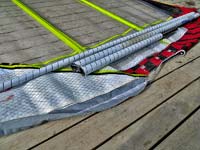
This Platinum mast broke the
normal way - just above the
boom. And just as normal
is the "collateral damage"
- a split open
sleeve.
Click the picture to enlarge.
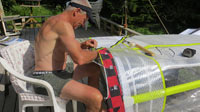
A long time ago I gave up sending
the Warps with destroyed sleeves
to the sail loft. In accumulation
it was simply too costly.
Repairing a sleeve by hand
(with contact cement, leather
string and holes made by a
very thin soldering iron)
normally takes 3-8
hours. Cheap, but the
resale value is totally
gone.
Click the picture to enlarge.
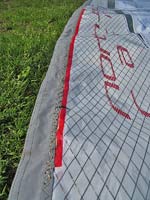
The result of another DIY
repair after yet another
Platinum breakdown.
Click the picture to enlarge.
In fact, you
probably
can't blame
only the Platinum mast itself
for
breaking and
all the consequences thereof: When rigging the Warps with masts
from other companies (and mast producers), the masts still break in the
Warps. I haven't got the statistics
to show that "foreign" masts break
in the Warps at the same alarming rate as the Platinum masts
have done - but
they do definitely break.
The problem seems to
be that,
in search of ultimate performance, the Warps have some extreme
luff curves that give the
masts a hard work. In fact, our
favorite Warps (performance wise) - the F2012
(and F2013)
- have
also eaten
the
most masts by far.
Warps from other years have also been hungry for
masts (we haven't had any experiences with
the F2014, as we
quickly
dumped our 7.8
due to odd trim), but the F2012's were the most gluttonous. I guess
that
a substantial cause (tough luff
curve) for
the extreme breaking
rate has
led to
this
promise by North
regarding the F2015
Warps
sizes 8.4 and up: "... the luff curve got reduced."
A promise that apparently doesn't include the 7.8 (according
to our experiences a mast breaking size
too!) and down.
So, durability-wise
some
Platinum masts sizes have been the
Achilles' heel
of the Warps,
and until North proves
that the Platinum mast breaking
problem is history, I'll hesitate to call the Warps (as part of the rig package) durable. But w
Regarding the company ...
North
is a
major
brand with a fine reputation of backing up their
products.
But there are exceptions:
In the spring 2013 a couple of our new Platinums 490 cm masts literally started braking around us. When addressing the importer we were told that Boards & More had informed that "there has been a failure on a production of 490 Platinum masts" (translated from Danish).
As we still had a new 490 cm Platinum masts left that hadn't broken yet, we (urged by our retailer, in fact) asked the imported if we could have it substituted with a specimen from a no-failure production. No need to experience a mast breaking on the water with all the implications (destroying the sail, a long and risky swim/paddling back to the shore, etc.), we thought.
But apparently the policy of North was to wait for the masts to break - not notifying people about the problems - and only send the costumers new masts when the socalled "failure production" masts broke and people reacted. North answered:
"We cannot replace a mast before it is broken. Please note not every Platinum
mast is breaking because of low serial number. Thanks for understanding."
I suspect that it
was
this questionable behavior
from North that was referred to in
this interview
on windsurf right-of-law in the German "surf" mag. from August 2014
(the relevant words marked with blue).
I have to praise the willingness of the product manager,
Raoul Joa, to answer your questions in depth. It's been a while since
I've addressed Raoul Joa, and I don't know if he's still around at
North. If he is, and if you have serious questions about the North
products, you'll probably get very honest answers from Raoul -
answers that are miles away from the sales babble you much too often get
from most other brands and
their team sailors(!). And if he asks for a little discretion in his
answers, that's the least you can do.
A company for the windsurfers or the shareholders?
The "corporate
cultures"
within the businesses for windsurf gear
probably moves towards a
global, universal short sighted, pure commercial way of thinking and
acting. I mean, the companies
of course
try to make us think that
their primary goal is to
develop
windsurf gear for the windsurfers
in love with windsurfing.
In reality, it's perhaps more
likely that it's
purely
about business,
and that
the companies
don't give a damn if
what they're developing, producing and selling
is windsurf
gear or chopped pork.
But of course there is room for variation, and the more we as windsurfers/costumers take decent behaviors of the companies into our considerations when choosing a brand, the more room for variety. I mean, there's a tendency to talk about "development" as something objective outside our control - often without wondering who is (also) driving the "development". We (the costumers and users of the products) are a driving force with our freedom to put feelings into our choices at the expense of more cynical incentives. We still have the option to not only hunt for the best products at the lowest prices - but to be guided by stupid concepts like, for instance, "sympathy".
Perhaps a little naive,
I still find at least some difference between North and for instance
Neil Pryde. If there is, in
fact, no difference in the
substance,
then I
will congratulate North for having been able to give me that
impression.
|
Warps
for the future? A personal note on race sail brand decision
making.
Unfortunately, choice of race sail brand from a performance
perspective is not so much about facts as about feelings and
trust to
the
designers, the design process and promo words. Why's
that? Well, except from a very few brands (Gun Sails?) you can't
go through the normal buying process when it comes to new race
sails. It's not like buying a car, where you can collect all the
information you like before actually deciding (reading the
specifications, examining others views, reading tests results,
having a test ride ... etc).
If
you decide that you need a couple of new race sails for
the coming season, you'll have to order the sails
from the retail
shop/the importer averaging 3 months before delivery (in my
country). The time when you could actually see and touch the
sails before ordering, and when you could learn from tests and
people around you how the sails performed, is long gone.
Generally the shops no longer have stocks of race sails to
choose from.
At the time
in the developing process when you have to order, you barely
know the specifications of the race sail. Often you'll have to
guess about the exact sizing (is it a 7.8 - or a 7.6 or a 7.9
for the next year?), you don't know if there's a change in masts
(recommended lengths, bend curves) or boom lengths (more or less
cut out?) than last years model - changes that might force you
to buy new hardware in addition to the sails. And what about the
design parameters - dare you rely on the declarations of intent
about more control, more power, softer handling etc.? And the
important magazine tests? Forget it - the magazine tests are
published looong after the deadline for ordering the sails. The
function of magazine tests these days is to give you a hint if
the sails you ordered 3 months ago are competitive sails or
doors.
The point is
that ordering new race sails is all about
confidence and
trust - in the
absence of the possibility of having the sails in your hands or
learning from the experiences of other sailors. And having to
trust the will, ability and words of designers and marketing
people of course opens for many relevant and irrelevant
speculations, as you're left in a twilight of uncertainty. In
the case of the future North Warps you might for instance
speculate ...
1. Are you
confident that the traditional Warp design peculiarities are a
sound a base for a competitive sail? For instance:
- By a
fair
margin the Warps traditionally have the smallest cut outs among
the race sails from various brands. Is this a deliberate choice
- or is it because the profile for whatever reason is designed
so stiff that a larger cut out would be counter-productive?
Speculations that are probably wrong ...
- The Warps
for several years have sticked to the 7 battens concept - while
the race sails from other brands mostly have 8 or even 9
battens. Is there a reason why other brands mostly opt for more
battens - for instance that this allows them to use less seam
shaping, for the benefit of a softer and more forgiving feel?
Does the Warp 7 battens concept so to speak lock the sails to a
stiff, unforgiving feel with little possibility to design a
damp, early planing sail? Speculations that are probably wrong
...
2. Is it
productive for your confidence in the Warp concept that you
several years in a row have been promised that NOW the new Warps
shall have competitive low end power - but that you exactly the
same number of years in a row have had to accept that this was
yet another unfulfilled promise.
3. Have you
faith in the people designing the Warps. What about Kai Hopf?
He's obviously following his own design route - but is this a
sign of an ability to design state of the art race sails - or is
it a sign of not being able to catch up with designers from
other brands, designers that the last several years have
launched race sails that generally have been higher valued by
magazine testers than the North Warps? And what about this new
man - Daniel Aeberli - that seems to be placed in the slot between
the designer and the international sailors (testers?) in both
North and Fanatic. What's his qualifications? Is he a guy with
drive and knowledge, or is he merely a smiling marketing guy?
This product from
his personal fin brand perhaps isn't too promising.
Again -
speculations that are probably wrong and unfair. But speculations
caused from having to decide which race sails to order with no
actually knowledge. And the less you know, the more paranoia ...
For me personally - also in the light in of my (to be nice) mixed experience with my latest Warp F2014 7.8 - I've decided not to buy any new Warps for the 2015 season. If the magazine tests of the F2015 Warps indicate that the Warps are catching up with the race sails from the other brands (performance wise and as to user friendliness in particular) I'll renew my quiver with new Warps in 2016 (I've got a lot of Platinum masts that can't be used with much other brands!). But if the magazine tests indicate that nothing has happened I'll probably switch to another brand in 2016. GA Vapor and Loftsails Racing Blade have been tested to be very balanced and friendly/comfortable sails for a couple of years - but so has the Gun Sails GS-R to some degree. And the GS-R has the advantage of at least having a chance to fit my later very Flex Top like Platinum 490 cm masts - as probably the only race sail brand on the market!
Update March 2015:
The
Planchemag Spécial Tests 2015 just arrived, and a quick look at
the slalom sail department ("Voiles de course 7,6-7,9 square
meters") confirms the worst expectations. Seemingly the North
Warp F2015 7.7 is even more peculiar than the Warps of the last
couple of years. In short it's the same old story - but perhaps
even worse: Top rates in lightness and rotation, but extremely
stiff and direct
(a big problem in chop, as
I understand)
with the worst rates in early planing and
control among the tested sails.
As said
elsewhere, according to North's description of the Warp F2015,
North seems to be well aware of the classic Warp performance
problems (late planing, lack of control and much to much
stiffness). Cite from http://www.north-windsurf.com/: "...
designer Kai Hopf has found the perfect balance between maximum
acceleration and optimum control when overpowered ... (the Warp
F2015 is) even more
powerful and much more flexible."
Sorry to say,
but if the 2015 test in Planchemag shows a right picture of the
Warp F2015, there's a huge gap between what the designer has
tried to achieve and what he has in fact been able to come up
with. And especially the two worst rankings are puzzling:
Normally the it seems to be highly problematic for the designers
to combine good rates in the Early Planing performance
and in the Control performance. If you score high on
Early Planing, you tend to score lower on Control - and vice
versa. And in the Planchemag 2015 test no brand succeed to score
highest rate in these two performance categories (closest are
Gaastra Vapor (9 and 10 respectively), Loftsails Racing Blade
(10 and 9) and Neil Pryde RS Racing (9.5 and 9.5). But what
about the North Warp? Pretty sensational the Warp scores the
worst rates in the test in both Early Planing and in
Control. That must be almost as difficult as to score high in
both performance categories!
Does this
make the new Warps to bad race sails. Of course not, in the
right hands the Warps can - and will - probably win races in
2015. But for us
ordinary mortals it'll be very tempting to seek the
brands making race sails that perform better AND are easier and
more friendly to sail.
What a pity that the people capable of making sails of a very high standard (durable wise) apparently haven't got the ability to design competitive slalom sails (performance wise) for sailors on a non-PWA level.
|
Update October/November 2015.
1.
More on mast breakings, the causes and sail durability.
Remember I
said that our F2012 Warps are the best performing Warps we've
had? Better than earlier Warps and better than later Warps. The
fact is that the very good performance of the F2012 Warp series
first and foremost seems to be a result of a very, very strong
luff curve that stabilizes the sails better than any other Warps
(in my view). However this luff curve comes at a price - and the
price is lack of durability. Durability for the masts and - very
seldom - durability of the sail.
It's no
secret that the very strong F2012 luff curve breaks a lot of
masts. My Warp F2012 8.6 alone has cost me 4 Platinum 490 masts
with a 3 times destroyed mast pocket when the masts broke out
through the sleeve.
I've noticed
a (potentially) very interesting phenomenon regarding the mast
breakings in this particular sail: The 4 masts broke in 4
distinct different spots in the sleeve: One in the boom cut out,
one just above the boom cut out, one further up the sleeve and
one yet further up the sleeve. Every time the masts broke out
through the original stitching of the sleeve at the same side of
the sail. Afterwards, the broken stitching was repaired (very
durable!)
by hand using
a
soldering iron and leather string,
totally without considering the resale value.
But why
haven't the masts broken out
through the sleeve at the same spot
twice? Why have the masts "chosen" a new and
not-strengthened/repaired spot to break out through? A
coincidence, or ...? What if the order isn't 1) mast breaking,
2) destroyed stitching? Isn't it feasible that the order is 1)
the very strong pre-bending of the mast (over-)loads the
stitching of the sleeve and makes it give up, and 2) the mast -
not being supported by the sleeve at the torn spot - is point
loaded and breaks.
This could
explain why the masts haven't been breaking at the same spot
twice, because the break-out spots on the sleeve are later
strengthened by the strong repairs. Probably not the whole truth
about the mast breakings in my Warp F2012 8.6. But perhaps part
of the truth?
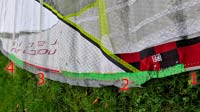
The Warp F2012 8.6 has
"consumed" 4 Platinum 490 cm
masts. All masts have broken
in a not-reinforced (= repaired)
spot. Was it in fact a weak
sleeve (bad stitching) that
caused the masts to break?
Click the pictures to enlarge.
The strong
luff curve of the Warp F2012 is probably the reason why the luff
of my Warp F2012 8.6 has cracked. This certainly isn't a normal
incident for the Warps (as it is for other brands, guess who?).
But when a luff cracks in a Warp it's kind of logical
that it happens in a Warp F2012.
Luckily, I
noticed the crack before it spread through the whole luff, so it
was relatively easy to repair (I've got a lot of experience in
the luff repairing business from
helping myself and my
windsurf buddies with our cracked Neil Pryde RS
Racings). I didn't report the cracked luff to North, as I've
learnt from earlier incidents that the 5 year warranty often
means a 50 Euros contribution to have the sail repaired at a
sail loft. At least in my country a sail loft will probably not
even open the sleeve for 50 Euros! Furthermore, it's my
experience that it's pretty seldom that sail lofts succeed in
repairing a cracked luff in a lasting way. I suspect that the
demand
from some costumers for an aesthetic
repair is the main reason for the bad statistics.
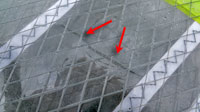
Certainly not a common sight with
sails from North: The luff on the
Warp F2012 8.6 has cracked.
Click the pictures to enlarge.
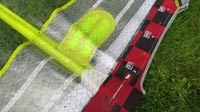
The crack is repaired by hand. An
aesthetic disaster - but much
stronger than letting a loft
do the job.
Click the pictures to enlarge.
2.
The North Platinum 490 cm bend curve evolution - and
implications for using new Platinums with older Warps.
I have to
say that reading the North homepage about the bend curves of
their masts grows increasingly surrealistic (see the bottom of
this page
http://www.north-windsurf.com/eng/nodes/display/pages/mast-technology).
No need to go into detail, but while a Platinum 2013 490 mast
typical had a bend curve of IMCS 15.8, my 2014 and 2015 Platinum
490 cm masts have been bend curve measured to around IMCS 17.8.
And my all new 2016 Platinum 490 mast has been measured to bend
curve IMCS 18.6!
Of course,
it's perfectly OK if the sails are designed around this kind of
Flex Top/Superflex Top bend curve masts - but why not tell us?
Why tell us that for instance the Neil Pryde masts can't be used
with the Warps because they're too Flex Top, when the truth is
that they are generally less Flex Top than the Platinum
490 and have bend curves very close to the Platinum 460? See
http://peterman.dk/masts-all-imcs01.htm.
Unfortunately, the Platinum 490 bend curve evolution caused me
to visit another brand (hopefully for a shorter period): When a
Platinum 490 cm 2013 mast (IMCS bend curve: 15.8) broke in my
Warp 9.2 F2013 I replaced it with a new Platinum 490 cm 2015
mast. However, the new mast turned out to be incompatible with
the sail. The lower part of the sleeve became very loose, but
even worse: The lowest camber simply couldn't stay put on the
mast. Different cambers from other brands and modifications of
North cambers were tried out, but in vain.
All this
happened mid-season, and as all Warps generally have to be
ordered pre-season at my place, I was forced to look for a
replacement sail from another brand. The choice fell on a Gun
GS-R 9.5, mostly because of the mast exchangeability between
North and Gun, but also because of a very competitive prizing
and a reputation for being attentive to the costumers.
How the Gun GS-R
9.5
sail performs compared to the Warps I'll
probably write a little about another time.
In the
meantime I've probably found a kind of solution on the problem
with the lowest camber falling off: Some Velcro fixed on the
camber and wrapped around the mast keeps the camber in place.
The solution works when rigged on the beach, but it hasn't been
tested on the water.
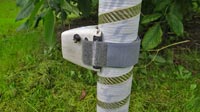
Facing incompability problems
with new (post-2013) Platinum 490
masts and older Warp sails?
A possible solution on "the
lowest camber falling off" issue.
Click the pictures to enlarge.
Receiving some new Warps F2016.
Generally,
the prizes for windsurf gear have raised to astronomic amounts
this year in my country. Rumours tell that the weak Euro
relative to the
We received
the sails at the beginning of October, and so far we've had some
4-5 sessions in far from optimal conditions. So, we certainly
haven't formed a firm opinion on the new Warps.
At the most
we've notice some sketchy outlines of their characteristics.
Performance
wise we've got the impression that the draft has moved somewhat
forward compared to our until now best Warps, the F2012 7.8 and
8.6. And perhaps I feel a tendency of a bit less stable drafts
compared to the F2012 Warps. At least the placement of the
harness lines aren't as obvious and distinct as I'm used to. But
still very, very interim impressions, gathered in gusty
conditions.
The sails
are very quick to get up in speed, and the top speed seems to be
comparable to the F2012 Warps (which is very good). In this very
early stage of the trimming process I have found it necessary to
lower the boom a couple of cm's to have my feet fixed securely
in the front straps. This is probably intended in the design, as
the boom cut-out seems to be placed a little lower compared to
the F2112 Warps.
The sails
feel a lot more compact than the F2012 and the F2013 Warps -
which in fact they are (a lot shorter luffs). So, not
surprisingly they feel somewhat more agile in the manoeuvres,
perhaps unless you're a light weight. They also feel a little
less direct and a little more "hesitating". They still
accelerate very good, but in a softer way than the F2012 Warps.
In the last
sessions we've had so far, the conditions were less challenging,
and when discussing our impressions we agreed on a
characteristic that's a little difficult to realize: The
average speed is very high. The F2016 Warps kind of don't
feel especially speedy in the peak moments, but when looking at
the surrounding sailors you're very competitive in the periods
when the conditions aren't ideal. And as the conditions are
seldom ideal for long periods, you have a good chance for being
in the lead after a couple of legs with the Warp F2016. Still
early days, but in a subtle way the new Warps seem to smooth out
the speed, compared to the more stiff on/off performance we've
got used to from earlier Warps.
My son is a
lightweight sailor, and the next time he takes his 8.4 on the
water he'll probably try it with an extended Platinum 460 mast
instead of the recommended Platinum 490 mast. To have an idea if
this is a
proper way to go, we've actually measured a Platinum
2015 460 mast (extended to 500 cm) and a Platinum 2015 490 cm
mast (extended to 500 cm), and the figures are:
Platinum
2015 490 cm mast extended to 500 cm (with 40 cm extension up in
the mast):
IMCS
stiffness: 28.7; IMCS bend curve: 17.9.
Platinum
2015 460 cm mast extended to 500 cm (with 15 cm extension up in
the mast):
IMCS
stiffness: 26.0; IMCS bend curve: 15.5.
The reason
he'll try the 460 cm mast setup with the sail is that the first
and only time he tried his Warp F2016 8.4 he found it a little
heavy in the jibes (in marginal wind, though).
As usual,
the first couple of sessions the cambers feel a bit sticky, and
you'll need a little wind to help them rotate. However, from
experience we know that after a few times on the water the
cambers rotate flawlessly. One of the 8.4's has been on the
water
4 times by now, and it already rotates as our good old
F2012s.
The all new
sleeve (made from a new non-stretch material) makes the sails
feel somewhat more crisp (camber rotation sounds like gun
shots!), and probably some of the performance advantages are
caused by this. However, the new sleeve construction also
demands that you rig the new Warps somewhat more gently than
older Warps. For instance, it's absolutely necessary to push the
cams (especially the lowest cam) in place from inside the
sleeve - contrary to what has been recommended in the pretty
old rigging manuals from North so far. If you try to push the
cambers in place from outside the sleeve you'll risk to damage
the non-stretch sleeve material severely. Oh - and of course
it's certainly not advisable to kick-rotate the cambers; and as
said, after a couple of sessions it's not necessary either.
As a matter
of fact we've already experienced the vulnerability of the
sleeve material: After the first (and so far only) session with
my sons all new Warp 8.4, it had some cracks around the lowest
camber. He was not aware that he had done anything bad to the
sail, and of course we at once asked a loft to repair and
strengthen the area. As a kind of insurance I told the local
importer about the issue - in case it should later happen to the
other new Warps too. And to my surprise the importer (having
been in contact with North) very quickly told me that it is
vital to rig the sails without pushing on the cambers from the
outside, as this may overload the sleeve material. And he pronto
changed the general North rigging instruction (for camber sails)
on his homepage. And a fortnight later North placed a new (and
revised) Warp rigging video on their homepage (https://www.youtube.com/watch?v=57czeE9zu1U&feature=player_embedded).
Both the
importer and North implicitly suggested that we had rigged
our
new Warps, following the old guidelines. And that this was the
cause for the cracks.
The
(potential) problem is that we've always rigged our Warps by
pushing on the cams from inside the sleeve, either through the
zipper openings or the boom cut-out, and so my son of course also did in
this case. And furthermore, the cracks showed on the port side
of the sail - that is to the opposite side to where the cracks
should arise, when you rig it zippers-up (starboard side up).
For now we just hope that my son by accident touched the sleeve too hard while sailing, and that this caused the cracks. But we'll be very observant if the problem will also show up on the other of the new Warps. I think that our Warps are from an early batch, and if so, North probably has the possibility to strengthen the lower part of the sleeves in future production series of the Warp F2016?
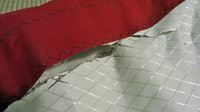
This may very well be the result if
you don't follow the new rigging
instruction on the Northsails
homepage: Cracks in the pretty
vulnerable sleeve material.
The actual damage did not
happen because of wrong
rigging procedure (see text).
Click the pictures to enlarge.
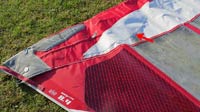
The cracked area repaired and
strengthened at a sail loft.
Click the pictures to enlarge.
|
Next
improvement of the Warps?
I think one
of the next steps for improvement among the race sail brands is
the centred placement of the batten pockets. As often is the
case (for instance the clew cut away, now adapted by all other
race sail brands), Neil Pryde is a forerunner here, presenting
the symmetric batten placement design in their RS EVO 6 series
in 2014. Hopefully the design will proliferate down the other
brands in the years to come.
*)
The classic
way to design a kind of symmetric sail is to place the
batten pockets alternately on either side of the sail. This is
also the case with the North Warps, where the longest batten
pocket (the one starting just under the boom cut out and ending
just above the clew) is placed on the port side of the sails.
The placement
of the longest batten pocket determines on which tack the most
important part of the leech of the sail "hooks" (flaps-down) or
"flips away" (twists, flaps-up). The more pressure you put on
the batten, the more pronounced the asymmetry.
Although
mostly a tendency (most felt with my Warp 7.7), on the new
Warps, I've noticed that on port tack the sails seem to have the
draft placed a bit more forward than on starboard tack. This
gives the sails a bit more stability on the port tack (the
twisting leech so to speak locks the draft in place forward) and
a bit more low end on starboard tack.
It's a
tendency that can be almost levelled out by the placement of the
harness lines. But unless you place the straps on your slalom
board a little asymmetric (on starboard tack a bit more
backwards to neutralize the backward draft of the sail) you'll
always risk the feel that your front foot on starboard tack is
sitting looser in the strap than on port tack. Unless, of
course, you lower the boom to get more pressure on the front
foot; but then it costs in early planing ... and so on. The
point is that a symmetric sail is a lot easier to trim. At least
in theory.
It's obvious that the hooking or
twisting leech issue has to be seen in connexion with the amount
of clew cut away, the placement of the clew eyelets and seam
shaping along the battens - but now it's becoming a bit
complicated. Here're some old (ignorant?) words about this
issue:
http://peterman.dk/windsurf-flaps-up01.htm.
It's
difficult to imagine how Neil Pryde has constructed the
symmetric placement of the batten pockets without creating a lot
of friction around the battens (making adjustments of a rigged
sail a hard work). But if it can be done without being too
vulnerable, it would be nice to have that feature in the future
Warps too.
And just to
put it in perspective: This issue with the Warps isn't nearly as
dominant as with some other race sail brands. For instance, my
2015 Gun Sails GS-R 9.5 sail way more asymmetric than any of my
Warps have ever done. Perhaps a result of much more clew cut
away, inappropriate placement of the clew eyelets (too low
relative to the dominant batten), simpler battens, looser batten
pockets, not ideal batten tension system, a seam shaping issue -
or just generally a way deeper sail?. The fact is that the very
asymmetric performance of my GS-R 9.5 caused me to place some
new foot strap plugs in my Fanatic Falcon 152, simply to place
myself further back on the board to get in line with the draft
on the starboard tack.
*)
For the
Severne Reflex race sails the Reflex system for years has
(partly) addressed the "asymmetric sail syndrome". And googling
the symmetric placement of battens it seems that the Simmer SCR
and the Avanti the Machine M-2 have entered this path too. It
also seems that Ezzy Sails has had their "Endobatten Shaping"
for years, but perhaps not for cambered sails(?).
|
A note on user reviews: Not a necessarily a punishment for the companies.
From a
reliable source I've got the impression that North isn't totally
satisfied with the reviews on this site. I think North should
be, and I'll try to explain why:
I think
there's a room between the babbling marketing folks and their
wagging tails (the obliging, but in reality say-nothing
sponsored sailors - and other professionals with interests in
biased views) - and the always negative,
over-critical
and not-constructive folks,
for whom nothing works and who see a conspiracy behind
everything.
It's in this
room most of us operate. Sometimes as small-talkers on the
beach, sometimes as readers and sometimes as writers. It's in
this room the better windsurf forums (for instance
http://www.seabreeze.com.au/forums/Windsurfing/) and the
better windsurf magazines (for instance the German "surf" mag.
and the French Planchemag mag.) are situated. Here lovers of the
windsurf sport exchange experiences and ideas, mostly cleaned
for irrelevant personal or corporate interests. In genuine
solidarity with other windsurfers the communication/reviews come
with honesty and modesty.
It's in this
room I try to give my small contributions to our sport. As an
(literally!) quite ordinary windsurfer - sailing perhaps a bit
too advanced equipment for my ability - I try to communicate
with other ordinary windsurfers who perhaps also sail equipment
on the border of their capability. I write what I find and
honestly mean, but I try to be fair and not too definitive in my
valuations. And unless finding very convincing evidence I
(usually) don't claim that what I've found is statistically
valid.
Why
should
companies like North welcome this kind of communication/reviews?
1.
Feed back.
All of us
know stories about bad, bad products that have partly destroyed
the reputation of a windsurf brand. Products, where bad designs
and flimsy "solutions" weren't changed for years, in spite of
massive warranty claims.
Of course,
it's costly to change a design, and probably it's not even
possible mid-season because the gear perhaps aren't manufactured
continuously, but in small series for stock. But that doesn't
explain why some companies don't rectify design and
manufacturing flaws for the next season. For instance, it simply
doesn't make sense that a major sail brand since 2004 for years
and years again didn't find a solution for the cracking luff
panels of their race sails. I mean, it's not rocket science to
strengthen a luff panel so that at least it doesn't crack for
the majority of the race sails. Other companies have had the
same problems, but to a much lesser degree. But more important:
If the race sails from other companies have shown similar
issues, they have (to my knowledge) rectified the problem the
following year. But not this major brand. Why?
I can only
find one explanation: Some companies simply don't receive real
feed back from the dealers and the importers. The
dealer/importer layer functions as a kind of "rockwoll layer"
between windsurfers with problems and the companies. The
companies simply don't get a realistic picture of the
dissatisfaction with their products among the costumers, because
the information is intercepted and handled in the
retailer/importer layer and never reach the company.
To follow the example, in my country the mentioned major brand have a very skilled (windsurf wise and commercial) importer, who apparently regard it as his task to "solve" the warranty problems by himself without (seemingly) involving the mother company. He takes action with much energy, very often by convincing the costumers that their claims are unfair and that they have to blame themselves.
Perhaps the
mother
company has defined his role like this, and probably the
company's very satisfied with his efforts.
But in fact it
shouldn't be. The prize for having a "wave-subduer" importer
might be that gear problems run for years without the company
having the full picture. And not having the full picture means
too little initiative to rectify.
In my place,
the recent years we've noticed a movement towards buying gear
from companies without a heavy (and expensive) importer/dealer
apparatus. That is companies that deal directly (or almost
directly) with the costumers. For instance, Gunsails has had a
big boost at my place, not only because of fine performance and
build quality at a very good prize, but also because of a
reputation for rectifying problems very quickly. To illustrate,
a couple of years ago Gun ran into a bad batch of masts from
their mast supplier. As soon as Gun realized the problem - which
I guess they did very quickly because of the direct
communication with their costumers - they mailed the buyers of
the bad masts and asked them to cut and return the 30 cm bottom
part of the masts. And within a fortnight the costumers received
some all new replacement masts. A pre-emptive action, before the
bad masts actually broke!
And a kind of
responsibility too seldom seen in the windsurf business.
The contrast to the years and years
again with
the
breaking Neil Pryde X9 masts without ANY action taken
by the company - except
from
blaming the costumers - is clearly
visible!
In general I
think the traditional chain from manufacturer to importer to
retailer to costumer is under attack. And not only because of
the on-line companies ability to cut the costs. Also - and more
important in this context - because of their ability to rectify
design and manufacturing flaws very quickly, based on the direct
communication with the users and costumers.
So,
companies with the traditional importer/dealer chain to the
users/costumers are exposed to the "rockwool layer" syndrome.
Especially for these companies the reviews
in the magazines, on
thge
internet forums and from individuals might be very useful,
perhaps essential - if they want the full picture.
2.
Choice of gear and decision making.
There's
another reason why the companies should be observant on the
unbiased windsurf communication/reviews: When I try to recall my
personal decision making process when buying windsurf equipment,
it's never based on a persuasive dealer or promotion stuff from
the companies. Most often I have a vague idea of my needs, so I
start to look for comparative tests in the magazines. Next step
is to search the internet for personal experiences (individual
writings and opinions on the forums). And if anyone on the beach
has some qualified input - or better: If anyone on the beach
show overwhelming performance without necessarily being a better
sailor than me - then of course I'm influenced.
The fact is
that I never choose equipment based on biased sources
like promotion stuff, dealer speech or team sailor babbling. Or
at least: Not that I'm aware of.
Of course I
read promotional stuff, watch promotional videos, listen to team
sailor stories, etc. But the interesting thing is the timing. On
a time-line, my need for biased information is always placed
after the
actual
decision making. When the gear's chosen and
ordered, I move into a phase of expectancy, mixed with a need
for confirmation: "Please tell me that I did the right choice."
And strange to say, the careful selected promotion stuff always
tell me
that
I've done the right choice.
If my
decision making procedure is representative for most
windsurfers, I think the windsurf companies ought to be
interested in the "un-authorized"
and un-biased
communication and reviews among windsurfers and use a less energy and money on
promotion that probably doesn't matter that much in the real
world.
So, my claim
is that what really moves us, is sober, balanced information.
And I don't see why serious windsurf companies shouldn't benefit
from user reviews, even if it contains fragments of
(constructive) critique. If a reviewer has a sober
critical/constructive approach,
perhaps
his/her
choice of
brand may have
